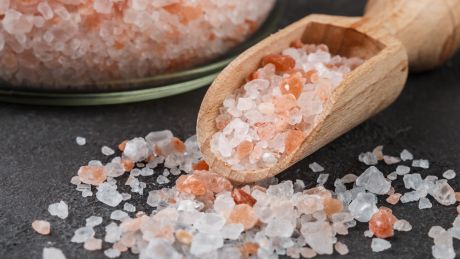Is Himalayan Pink Salt Good For You, Or Are Its Benefits Oversold?
Without wishing to sound salty, it’s probably not worth bothering with

As exciting new superfoods go, Himalayan pink salt has all the right credentials. The name gives it an exotic mystique while also highlighting its Instagram-friendly colour. Sounds much better than boring old table salt already.
Unfortunately, once you look beyond the name and colour, there are few reasons to recommend a switch from table salt to Himalayan, especially as the latter is far more expensive. We spoke to dietitian and British Dietetic Association spokesperson Clare Thornton-Wood for the lowdown on Himalayan pink salt.
How is Himalayan pink salt different to table salt?
The key ingredient in all salt is the same – sodium chloride – but there are some differences between table salt and Himalayan salt.
“Himalayan salt does contain trace amounts of a number of minerals that are not found in regular table salt, or are in Himalayan salt in larger quantities, for example calcium, potassium, molybdenum and iron,” says Thornton-Wood.
“Himalayan pink salt also has a lower sodium content than table salt – 84% as opposed to 98%.”
There are also a couple of ingredients added to table salt, mainly with the purpose of making it less likely to clump.
“Table salt has an anti-caking agent added to it,” says Thornton-Wood, “while Himalayan rock salt does not.” This is often a man-made substance called sodium aluminosilicate.
Sign up for workout ideas, training advice, reviews of the latest gear and more.
“Some table salt has iodine added and this can be a useful source of this mineral which is often lacking in our diets,” says Thornton-Wood. “A lack of iodine can cause hypothyroidism and mental retardation. However, there are other dietary sources of iodine such as fish, dairy and eggs.”
Are there any health benefits to using Himalayan pink salt compared to table salt?
Trace minerals. That’s the key benefit to Himalayan pink salts proclaimed by its advocates. Unfortunately trace minerals really means trace minerals.
“The trace amounts of minerals in Himalayan rock salt are very small and will not make any difference to the recommended intake of these minerals,” says Thornton-Wood.
“You will definitely not get enough of these minerals by eating Himalayan rock salt and indeed many of them are not necessary in the human diet. For example, the RNI [Reference Nutrient Intake, basically how much you should consume] for potassium for an adult is 3.5g per day. If you consumed 100g Himalayan salt you would get 3g of potassium. Eating 100g of Himalayan salt equates to around 20 teaspoons and apart from practicalities, this would far exceed safe levels for sodium.”
RECOMMENDED: Everyone Is Freaking Out About Salt, So Here’s What You Need To Know
Even the fact that Himalayan pink salt is lower in sodium can be a double-edged sword, as it might make you use more of it to get the same amount of flavour as with table salt.
“The only possible benefit is Himalayan salt does not have an anti-caking agent added so if you want to avoid additives this might be a better choice,” says Thornton-Wood.
For the moment, there is nothing to suggest that switching to Himalayan pink salt will have an effect on anything apart from your wallet. Unless you prefer the taste of course, in which case knock yourself out.

Nick Harris-Fry is a journalist who has been covering health and fitness since 2015. Nick is an avid runner, covering 70-110km a week, which gives him ample opportunity to test a wide range of running shoes and running gear. He is also the chief tester for fitness trackers and running watches, treadmills and exercise bikes, and workout headphones.
